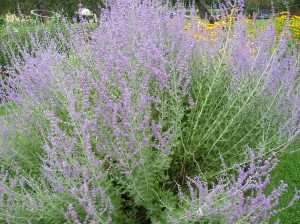Other Name
Azure sage
Sun Requirements
Full sun
Bloom Period and Seasonal Color
Mid-summer to fall in different shade of light and lavender blue.
Mature Height x Spread
1 to 4 feet x 1 to 3 feet
Added Benefits
drought tolerant, attracts beneficials, deer resistant
Russian sage has become one of the new darlings for low maintenance perennial gardens. The tall airy plant has fragrant, grey-green foliage reminiscent of the Western sagebrush, with spiky lavender blue flowers. The most outstanding feature of this perennial is its carefree nature. You really can plant it and forget about it. It tolerates dry conditions and below average soil fertility, attracts butterflies, and isn’t bothered by insects or animals. Since it blooms from summer to fall it adds great foliage and flower color to the garden when few other flowers are blooming. It’s equally valuable grown en mass, looking like a purple haze in the garden when in bloom, to being grown near other bright colored annual and perennial flowers.
Where, When and How to Plant
Russian sage grows throughout our region. You can start plants from seed, but it’s easier, and more likely to flower the first year, if you purchase transplants from a local garden center or receive divisions from a friend’s garden. Plant Russian sage from spring to early fall, spacing plants 2 to 3 feet apart. Russian sage likes full sun and tolerates almost any soil conditions as long as the soil is well drained.
Growing Tips
Keep first year plants well watered. Once established Russian sage is drought tolerant. A light layer of compost in spring is all that’s required for fertilization.
Regional Advice and Care
Russian sage tolerates alkaline soil and salty, windy conditions. It’s a good choice to grow near the ocean. Russian sage can tend to flop, as the stems get long. To prevent flopping grow shorter varieties, stake or cage your plants or pinch back the growing tips when the plant is 1 foot tall. Divide plants every 3 to 4 years to encourage better flowering. Dig up the whole clump of Russian sage in spring; divide it into wedge-sized pieces and replant in a location with similar growing conditions. Deadhead spent flowers to encourage more blooming into fall. The flower heads also look attract when left to dry on the plant to provide winter interest in the garden.
Companion Planting and Design
Russian sage grows well in a sunny flower border next to other grey-green foliage plants such as lamb’s ears and artemisia. The plant can grow a bit rangy so don’t plant it in a formal border. The soft foliage and blue flowers also contrast well with bolder colored yellow and orange flowers such as coreopsis and daylilies. Plant Russian sage near rock walls or as a backdrop in rock gardens since it enjoys well-drained soils.
Try These
“Blue Mist” has pale blue colored flowers. “Longin” grows more upright and it less likely to flop over. “Little Spire” only grows 2 feet tall. “Filigran” has more dissected leaves with an even airier appearance than the species form.
Excerpted from my book, New England Getting Started Garden Guide.



